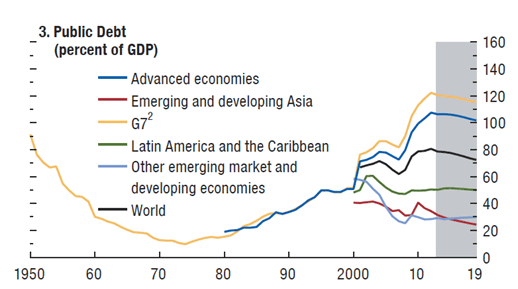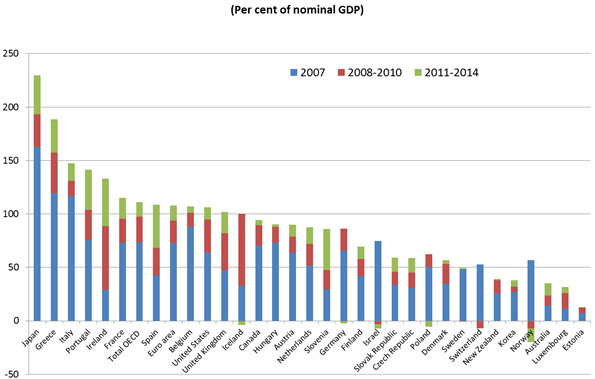The world economy is in a fragile state. While the United State is recovering and Japan has in place the three arrows policy in an attempt to jump start the economy, Europe is mired in economic difficulties in countries outside of Germany. China is also undergoing important financial and economic reforms in an effort to sustain its development strategy and to resolve the emergence of internal imbalances.
The immediate issue facing policymakers in many countries relates to the adjustment of monetary policies in major economies. The U.S. Federal Reserve Bank is close to ending the period of Quantitative Easing which implies a gradual increase in U.S. and probably world interest rates. Japan has undertaken a massive quantitative easing as part of the three arrows policy. Europe has embarked on a period of negative policy interest rates which will likely be followed by a period of Quantitative Easing although there is opposition to this by Germany within the Eurozone. The asymmetry in the monetary adjustment is a critical issue. In addition many emerging economies have been attempting to prevent their own currencies from appreciating relative to the major economies and have therefore been following very loose monetary policies. As the United States begin to normalize interest rates there is likely to be a large flow of capital out of other economies into the U.S. This will put additional pressure on economies with large public or private debt burdens and low economic growth rates. Increasingly as global real interest rate begin to rise, countries facing large government debts will need to embark on fiscal consolidation. In some cases this consolidation will need to be very large.
Figure 1 shows the evolution of public debt (as a percent of the gross domestic product (GDP)) over the past 60 years for various regions of the world economy together with the International Monetary Fund (IMF) recent forecasts of gross government debt to GDP ratios to 2019. It is clear from Figure 1 that global debt to GDP ratios have risen sharply since 2001 in response to the dot-com bubble bursting in the United States and again from 2009 in response to the great recession--particularly in the advanced economies. Under the convention that a sustainable debt to GDP ratio is around 60% there is clearly a large part of the global economy that will need policies to reduce fiscal debt. Some good news from this figure is that much of the problem is not global in nature but is concentrated in the advanced economies rather than the emerging economies.

Figure 2 gives a clear picture of how the fiscal debts are distributed across the Organisation for Economic Co-operation and Development (OECD) economies. This figure contains three stacked bars for each economy in the OECD. The countries run from left to right across the horizontal axis are in order of the aggregate size in gross debt to GDP as of 2014. The bottom bar for each country (in blue) is the government debt to GDP in that country in 2007 before the global financial crisis. The middle bar (in red) is the government debt that was added during the period 2008-2010 during the crisis. The top bar (in green) is the government debt that has been added and is forecasted to be added by the end of 2014.

[Click to enlarge]
Just as the fiscal experience across countries of different levels of development globally has varied, so there has been a diversity of experience within the OECD economies. This is significant because it makes it clear that some regions of the world will have to do a substantial amount of fiscal reform while others will not need to adjust. Thus there is a major asymmetry in the adjustment in the global economy as well as within economic regions such as within the Eurozone. This asymmetry is important because it implies a substantial impact of fiscal adjustment on trade balance between countries and real exchange rates between economies.
There are at least two interesting aspects of the coming fiscal consolidation at the global level. The first is the implication for aggregate demand in the world as governments cut spending or raise taxes in order to reduce government debt (Note 1). There is a substantial debate about whether countries going back into recession in Europe and elsewhere should be using fiscal policy to stimulate the domestic economy. Paper such as Alesina and Perotti (1995) and Giavazzi and Pagano (1990) suggest that fiscal contractions can even be stimulative in the short run. This is also shown in McKibbin and Stoeckel (2012). In that paper a sharp fiscal contraction reduced aggregate demand in the short run but the fiscal contraction is credibly phased in over time so that the benefits of lower financing costs and lower expected future tax liabilities can simulate the economy before the government spending is withdrawn. However it is difficult not to get an economic slowdown at the peak of the fiscal deficit reduction policy. There is also a debate about the importance of the zero lower bound in interest rates on the fiscal multiplier (Note 2). One of the usual offsets to fiscal contraction is lower nominal interest rates which dampen the demand contraction. At a zero lower bound interest rates cannot fall and the fiscal multiplier should be larger. The same problem occurs within a single currency area such as the Eurozone where a fiscal contraction in a small country within the zone does not change the European Central Bank (ECB) interest rates and so the negative fiscal multiplier is larger for countries that are pegging their exchange rate.
The second implication is the impact on trade and international capital flows. Given the current account balance is the difference between savings and investment of a country, there are potentially important impacts of asymmetric fiscal contraction on global trade. A reduction in the budget deficit is a rise in government saving. To the extent that consumers recognize lower future tax liabilities and therefore reduce private savings this will be offset but the evidence suggest the net saving of households and government will rise (i.e., consumers are not completely Ricardian). Investment is likely to fall, at least initially, because of the impact of fiscal contraction on short term aggregate demand which reduces economic activity. In the longer run the adjustment leads to more private investment (see McKibbin and Stoeckel (2012)) but this would likely take several years due to short term Keynesian effects. The likely outcome in the short term is a rise in national saving and a fall in national investment which implies a capital outflow from fiscally contracting economies. This capital outflow will depreciate the exchange rate of the economies undergoing fiscal contractions and appreciate the exchange rates of the economies who are not adjusting. This movement in capital which drives changes in real exchange rates will therefore lead to change in trade balances of a scale that matches the capital outflow. Thus countries contracting fiscal deficits will experience an improvement in their trade balances and countries not adjusting will experience deterioration in their trade balances. The magnitude will vary across countries but the effects are potentially large as shown in McKibbin, Stoeckel and Lu (2014).
The adjustment of real exchange rates will either occur through changes in the nominal exchange rate in floating countries, or if countries are pegging to another country, a change in domestic inflation. A country with a fixed exchange rate and cutting fiscal deficits is likely to see a fall in domestic inflation which under large fiscal consolidation could be deflationary. The adjustment in southern European economies is a case in point. Another example is the extent to which a country pegs to the United States which happens to also require a fiscal contraction. Even if it was not adjusting its own fiscal policy, the pegging country would need to have loose monetary policy to hold the nominal exchange rate peg and so the shock is likely to be inflationary in the short run. Whether through the nominal exchange rate or higher domestic inflation, the real exchange rate of the pegging country would appreciate.
Thus the need for global fiscal adjustment in the coming decade will put enormous pressure of global trade and financial markets and potentially political pressure on economies experiencing large capital inflows resulting from capital flowing out of countries undertaking fiscal contractions. This will require a level of coordination of global monetary and fiscal policies that has been absent for several decades.
While the world waits for the outcome of asymmetric monetary adjustment in 2014, the fiscal adjustments that are required are likely to have far more real consequences for the global economy in the years ahead.


